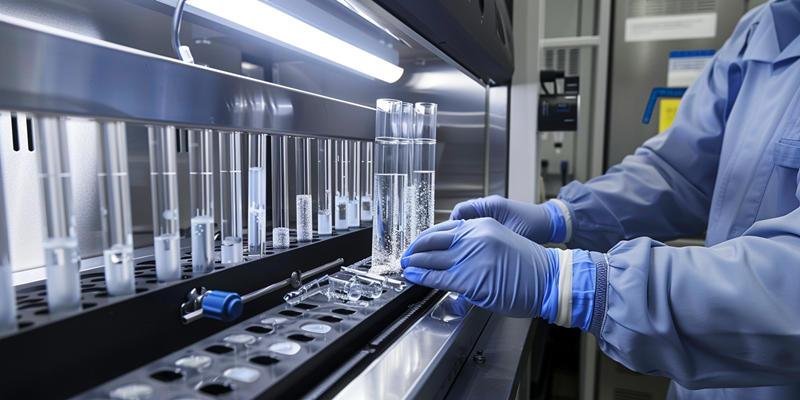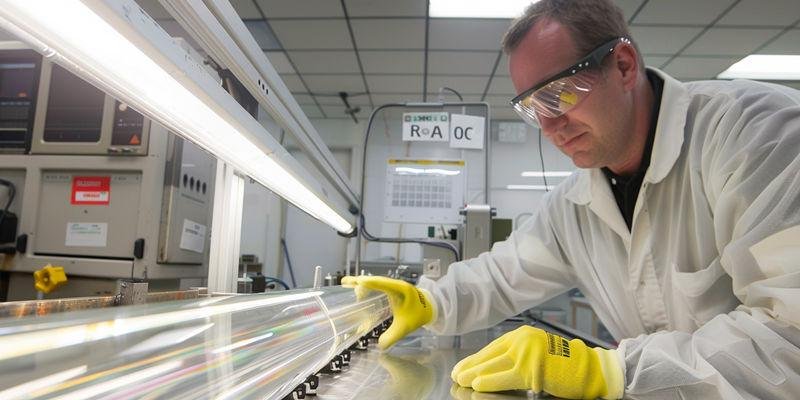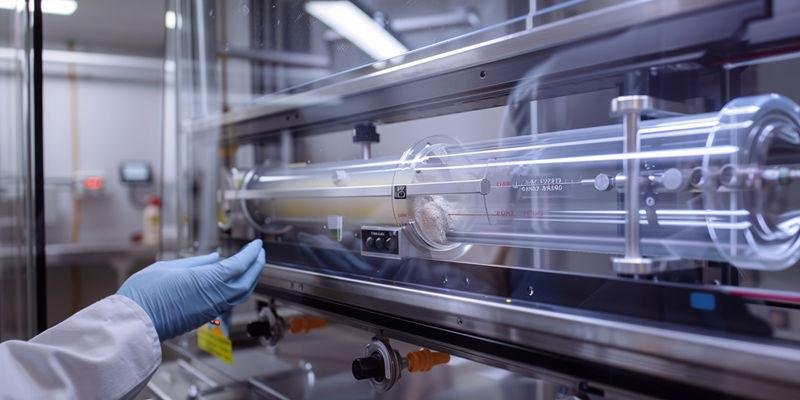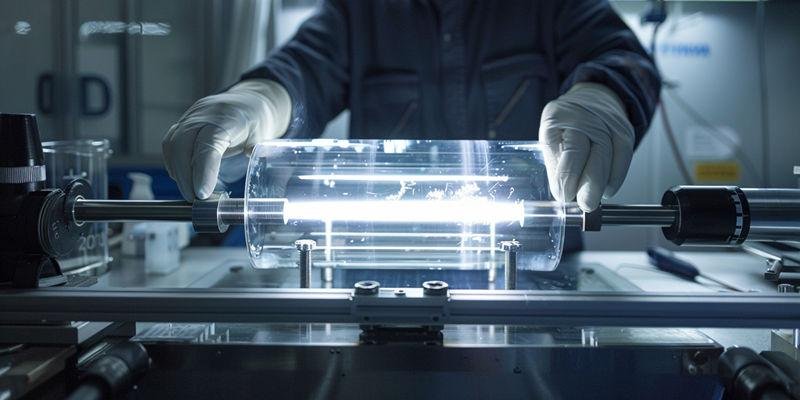
Optical purity determines how much ultraviolet light passes through quartz glass tubes, especially at shorter wavelengths. Even small increases in impurities can cause significant losses in UV transmission, making high optical purity essential for applications that demand precise UV control.
Medical industry professionals rely on quartz glass tubes to deliver exact UV wavelengths for therapeutic devices.
Laboratory researchers use optical purity quartz glass tubes UV transmission to ensure accurate readings in spectrophotometers and analyzers.
Industrial facilities depend on quartz glass tubes for reliable UV sources in photolithography and curing equipment.
Optical instruments require quartz glass tubes with high optical purity to improve chip manufacturing and data precision.
Selecting the right purity and surface quality in quartz glass tubes ensures optimal UV performance for each application.
Key Takeaways
High optical purity in quartz glass tubes is crucial for maximizing UV light transmission, especially for applications requiring precise UV control.
Even small increases in impurities can significantly reduce UV transmission, making it essential to select quartz glass with at least 99.98% SiO₂ purity for deep UV applications.
Different metallic contaminants like aluminum, titanium, and iron can block specific UV wavelengths, so controlling these impurities is vital for maintaining high UV performance.
Facilities should balance the cost of ultra-high purity quartz glass with the performance benefits, ensuring they choose the right purity level for their specific UV application needs.
Regular testing and certification of quartz glass purity help ensure reliable UV transmission, supporting consistent performance in sensitive applications.
What Purity Threshold Enables Deep UV Transmission Below 220nm?

Deep ultraviolet transmission in quartz glass tubes depends on the material’s optical purity. Even small changes in impurity levels can cause large differences in how much ultraviolet light passes through. Understanding why purity matters helps users select the right quartz glass for their application.
Relationship Between SiO₂ Content and UV Absorption Edges
SiO₂ purity directly controls the ultraviolet transmission properties of quartz glass tubes.
Higher SiO₂ content reduces the number of impurity centers that absorb ultraviolet light, which shifts the absorption edge to shorter wavelengths and allows more deep UV light to pass through. For example, quartz glass with 99.98% SiO₂ purity enables ultraviolet transmission below 220nm, while each 0.01% increase in impurities can cause a 3-5% drop in transmission at these wavelengths.
This non-linear relationship means that small improvements in purity can lead to significant gains in optical purity quartz glass tubes uv transmission.
Key Factor | Impact on Ultraviolet Transmission |
|---|---|
SiO₂ Purity >99.98% | Enables deep UV transmission below 220nm |
Impurity Increase | Causes rapid transmission loss, especially below 200nm |
Absorption Edge Shift | Higher purity shifts absorption edge to shorter wavelengths |
Specific Impurity Effects on Wavelength-Dependent Transmission
Aluminum, titanium, and iron impurities each create unique absorption edges that limit ultraviolet transmission at specific wavelengths.
Aluminum blocks transmission below 210nm, titanium absorbs strongly between 200-250nm, and iron reduces transmission across the entire UV range, causing visible coloration and broad-spectrum loss. These impurities act as centers that absorb UV photons, so even a few parts per million can sharply reduce optical purity quartz glass tubes uv transmission.
Facilities must control these impurities to achieve high ultraviolet transmission for sensitive applications.
Summary of Impurity Effects:
Aluminum: Shifts absorption edge, blocks deep UV.
Titanium: Reduces transmission in mid-UV.
Iron: Causes broad-spectrum loss and visible color.
Cost-Benefit Analysis of Ultra-High Purity Specifications
Ultra-high purity quartz glass offers the best ultraviolet transmission, but costs rise quickly as purity increases.
Upgrading from 99.98% to 99.99% SiO₂ purity can boost transmission at 200nm from about 70% to nearly 88%, yet further increases to 99.995% purity only add 2-3% more transmission while doubling material costs. Users should weigh the benefits of improved optical purity quartz glass tubes uv transmission against the higher expense, especially if their application does not require maximum ultraviolet transmission at the shortest wavelengths.
Selecting the right purity ensures optimal performance without unnecessary spending.
Purity Level | Transmission at 200nm | Cost Impact |
|---|---|---|
99.98% | ~70% | Standard |
99.99% | ~88% | Higher |
99.995% | ~90% | Much higher |
Which Metallic Contaminants Most Severely Degrade UV Optical Performance?
Quartz glass tubes play a vital role in transmitting ultraviolet light for scientific and industrial uses. The presence of certain metallic contaminants can sharply reduce ultraviolet transmission, especially at critical wavelengths. Understanding why these contaminants matter helps users select the right quartz glass for their ultraviolet applications.
Transition Metal Electronic Transitions Causing UV Absorption
Transition metals in quartz glass absorb ultraviolet light through electronic transitions. These metals, such as aluminum, titanium, and iron, create absorption centers that block ultraviolet light at specific wavelengths. The presence of these metals in quartz glass causes a rapid decline in ultraviolet transmission, especially below 250nm.
Aluminum in quartz glass shifts the ultraviolet absorption edge, blocking deep ultraviolet light below 210nm. Titanium absorbs ultraviolet light strongly between 200nm and 250nm, while iron increases ultraviolet absorption across a broad range and causes visible coloration. These effects result from the way transition metals interact with ultraviolet photons, making even small amounts of these metals a major concern for ultraviolet performance.
Summary of Key Effects:
Aluminum: Blocks deep ultraviolet below 210nm
Titanium: Reduces ultraviolet transmission in the 200-250nm range
Iron: Increases ultraviolet absorption and causes visible color
Impurity Limits for Specific UV Wavelength Applications
Quartz glass must meet strict impurity limits to ensure high ultraviolet transmission. Each metallic contaminant has a critical threshold, measured in parts per million (ppm), that determines its effect on ultraviolet performance. Exceeding these limits can cause significant losses in ultraviolet transmission for sensitive applications.
For ultraviolet optics and photolithography, iron must remain below 0.5 ppm to prevent increased ultraviolet absorption. Aluminum and titanium also require tight control, with typical limits set to ensure the absorption edge does not shift into the working ultraviolet range. The following table summarizes the main effects and critical concerns for each contaminant in quartz glass:
Impurity | Typical Limit (ppm) | Main Effect | Critical Concern for Application |
|---|---|---|---|
Iron (Fe) | <0.5 | Increases ultraviolet absorption | UV optics, photolithography |
Aluminum (Al) | <5 | Shifts ultraviolet absorption edge | Deep ultraviolet applications |
Titanium (Ti) | <3 | Reduces ultraviolet transmission | Germicidal ultraviolet, spectroscopy |
Maintaining low impurity content in quartz glass ensures reliable ultraviolet performance for demanding applications.
Analytical Testing Methods for Metallic Contamination Verification
Facilities use advanced analytical methods to verify metallic contamination in quartz glass for ultraviolet applications. These methods detect even trace amounts of metals that can affect ultraviolet transmission. Accurate testing ensures that quartz glass meets the required purity standards for ultraviolet use.
Inductively coupled plasma mass spectrometry (ICP-MS) detects metal impurities in quartz glass with high sensitivity. Helium mass spectrometer leak detectors verify the sealing integrity of quartz glass tubes, preventing contamination from leaks that could introduce new metallic impurities. The table below highlights the main testing methods and their purposes:
Method | Purpose |
|---|---|
ICP-MS | Detects metal impurities in quartz glass tubes |
Helium mass spectrometer leak detector | Verifies sealing integrity to prevent contamination from leaks |
Certified impurity profiles from these tests give users confidence in the ultraviolet performance of their quartz glass tubes.
How Does Purity-Related Absorption Mechanism Differ Across UV Wavelength Ranges?
Quartz glass tubes transmit ultraviolet light with efficiency that depends on both purity and surface quality. Different absorption mechanisms affect transmission at various ultraviolet light wavelengths. Understanding these mechanisms helps users select the right quartz glass tube for their specific ultraviolet light application.
Electronic Absorption Edge Physics for Common Metallic Contaminants
Metallic contaminants in quartz glass create distinct absorption edges that impact ultraviolet light transmission. Aluminum, titanium, and iron each introduce electronic transitions that absorb ultraviolet light at specific wavelengths. These transitions cause rapid transmission loss below 200 nm, where metal impurities dominate absorption.
Aluminum shifts the absorption edge, blocking ultraviolet light below 210 nm. Titanium absorbs ultraviolet light strongly between 200 nm and 250 nm, while iron causes broad-spectrum absorption and visible coloration. The presence of these metals in quartz glass tubes explains why transmission drops sharply in the deep ultraviolet light range.
Key Points:
Aluminum: Blocks ultraviolet light below 210 nm
Titanium: Absorbs ultraviolet light between 200–250 nm
Iron: Reduces transmission across ultraviolet light and visible spectrum
Wavelength-Dependent Transmission Loss Calculations from Impurity Profiles
Transmission loss in quartz glass tubes varies with both impurity profile and ultraviolet light wavelength. Below 200 nm, metal impurities cause the most significant absorption, while anoxic structures contribute to absorption near 240 nm. Transition metal ions also affect transmission in the visible band, and hydroxyl groups show absorption peaks at 2730 nm.
A quartz glass tube with 99.98% SiO₂ purity transmits about 70% of ultraviolet light at 200 nm, but increasing purity to 99.99% boosts transmission to nearly 88%. The exponential relationship between impurity concentration and transmission loss means small changes in purity can have large effects at shorter ultraviolet light wavelengths.
Wavelength (nm) | Main Absorption Mechanism | Transmission Loss (%) |
|---|---|---|
<200 | Metal impurities | 15–30 |
200–250 | Anoxic structures, Ti | 10–20 |
Visible band | Transition metals, Fe | 5–15 |
Targeted Purity Specification Strategies Based on Working Wavelength
Facilities must match quartz glass tube purity to the working wavelength of their ultraviolet light system. For deep ultraviolet light applications below 200 nm, ultra-high purity quartz glass with minimal metallic impurities is essential. Applications using ultraviolet light above 250 nm can use standard high-purity quartz glass, which offers good transmission at a lower cost.
Surface polish also affects measured ultraviolet light transmission, especially at short wavelengths. A precision optical polish (scratch-dig 40-20) improves transmission by 3–5% at 200 nm compared to commercial polish (60-40), making it ideal for sensitive ultraviolet light applications. Users should balance cost and performance by specifying purity and surface finish based on the minimum required transmission at their target wavelength.
Application Wavelength | Recommended Purity | Surface Finish | Cost-Performance Guidance |
|---|---|---|---|
<200 nm | ≥99.99% SiO₂ | 40-20 | Highest performance, higher cost |
200–250 nm | 99.98% SiO₂ | 60-40 | Good transmission, moderate cost |
>250 nm | 99.95% SiO₂ | 60-40 | Cost-effective, adequate for most uses |
What Purity Verification Methods Distinguish Optical-Grade from Industrial-Grade Material?

Quartz glass tubes for uv applications must meet strict standards to ensure reliable performance. Facilities use advanced verification methods to separate optical-grade material from industrial-grade alternatives. These methods help users achieve consistent uv transmission and maintain quality in demanding environments.
Comparative Sensitivity of ICP-MS, XRF, and GDMS Purity Analysis
Testing methods like ICP-MS, XRF, and GDMS provide different levels of sensitivity for detecting impurities in quartz glass used for uv systems. ICP-MS identifies trace metals at parts-per-billion levels, while XRF offers rapid screening for bulk contaminants, and GDMS excels at profiling ultra-low impurity concentrations. Facilities rely on these methods to confirm that quartz glass tubes meet uv transmission requirements and maintain optical-grade standards.
ICP-MS delivers high sensitivity for metallic impurities, making it ideal for verifying uv-grade quartz purity. XRF allows quick assessment of larger batches, supporting routine quality checks for uv applications. GDMS provides comprehensive impurity profiles, ensuring that even the smallest contaminants do not affect uv transmission.
Method | Sensitivity | Best Use for UV Applications |
|---|---|---|
ICP-MS | Highest | Trace metals, optical-grade |
XRF | Moderate | Bulk screening, industrial-grade |
GDMS | Ultra-high | Full impurity profile, uv-critical |
Interpreting Impurity Profiles for UV Transmission Prediction
Impurity profiles help predict how quartz glass tubes will perform in uv systems. Facilities analyze impurity levels to estimate transmission losses at specific uv wavelengths. Lower impurity concentrations lead to higher uv transmission, especially in deep uv applications where purity matters most.
Engineers use impurity data to select quartz glass tubes that match the uv requirements of each system. By comparing impurity profiles, they can forecast transmission rates and avoid unexpected losses in uv performance. This approach ensures that only tubes with verified purity support sensitive uv processes.
Key Takeaways for UV Transmission Prediction:
Lower impurity levels mean better uv transmission
Impurity profiles guide material selection for uv systems
Consistent uv performance depends on verified purity
Certification Requirements for Optical-Grade Purity Validation
Certification standards validate the purity and uv performance of quartz glass tubes. Organizations require ISO 9001 for process control, ISO 12123 for production reliability, ASTM for testing benchmarks, and SEMI for semiconductor uv applications. These certifications guarantee that quartz glass tubes meet strict uv transmission and purity criteria.
Batch-specific purity certificates document impurity levels and confirm that each tube supports consistent uv quality. Facilities depend on these certificates to ensure traceability and maintain high standards for uv applications. Certification builds trust and helps users select the right quartz glass tubes for their uv needs.
Certification | Purpose |
|---|---|
ISO 9001 | Quality control |
ISO 12123 | Production reliability |
ASTM | Testing benchmarks |
SEMI | Semiconductor uv standards |
How Do Purity Requirements Scale with UV System Sensitivity and Wavelength Demands?
Quartz tube purity requirements change based on the sensitivity of the UV system and the wavelengths involved. Engineers must match the material’s purity to the application’s needs to avoid unnecessary costs and ensure reliable performance. Understanding these relationships helps facilities select the right tube for each UV process.
Application Sensitivity Thresholds for Purity Specification
Application sensitivity determines the minimum purity needed for each quartz tube.
Sensitive UV systems, such as those used in semiconductor manufacturing or pharmaceutical sterilization, require tubes with extremely high purity to prevent contamination and maintain optimal performance. These industries rely on quartz tube materials with at least 99.995% SiO₂, which ensures minimal light scattering and absorption.
A tube with lower purity may introduce unwanted background noise, reducing the accuracy of sensitive measurements.
Purity Level | Application Sensitivity | Implications |
|---|---|---|
≥99.995% SiO₂ | High (semiconductor, pharma, sterilization) | Prevents contamination, ensures optimal performance |
99.99% SiO₂ | Moderate (analytical, research) | Reliable transmission, lower cost |
99.98% SiO₂ | Standard (general lab, UV-A) | Adequate for routine work |
Wavelength-Purity Correlation Matrix for Optimal Material Selection
The working wavelength of a UV system guides the choice of quartz tube purity.
Shorter wavelengths, especially below 220nm, demand higher purity tubes to minimize absorption and maximize transmission. For applications above 250nm, standard purity tubes often provide sufficient performance, allowing facilities to optimize costs.
Selecting the right tube based on wavelength ensures that each process receives the necessary optical clarity without overspending.
Wavelength Range | Recommended Quartz Tube Purity | Typical Application |
|---|---|---|
<200 nm | ≥99.99% SiO₂ | VUV spectroscopy, photolithography |
200–250 nm | 99.98% SiO₂ | DNA/protein analysis, germicidal UV |
>250 nm | 99.95% SiO₂ | General lab, UV curing |
Summary for Material Selection:
Match tube purity to application wavelength
Higher purity for shorter wavelengths
Standard purity for routine UV work
Cost-Benefit Analysis of Purity Upgrades Across UV Application Types
Facilities must weigh the benefits of higher purity quartz tube materials against increased costs.
Upgrading from standard to ultra-high purity tubes can improve transmission by up to 18% at deep UV wavelengths, but the cost may double for only a small gain in less sensitive applications. For most laboratory and industrial uses above 250nm, standard purity tubes offer reliable performance at a lower price.
Choosing the right tube for each UV system helps balance performance and budget.
Key Cost-Benefit Points:
Ultra-high purity tubes are essential for critical UV measurements.
Standard purity tubes provide cost-effective solutions for routine applications.
Avoid over-specification to optimize both performance and spending.
Optical purity and surface quality play a vital role in achieving strong UV light transmission in quartz glass tubes. Facilities should match purity and finish to the specific UV wavelength needed for each application. To balance performance and cost, consider the following:
Meet ISO and SEMI standards for UV transmittance and surface roughness.
Compare bulk pricing and order sizes to manage expenses.
Request certified test reports with impurity analysis and batch traceability.
Selecting the right specifications ensures reliable results without unnecessary spending.
FAQ
What makes high purity quartz glass essential for germicidal applications?
High purity quartz glass allows more ultraviolet light to pass through, which increases germicidal effectiveness. Facilities use it in uv germicidal lamp systems to ensure high transmittance and reliable disinfection. High purity also reduces unwanted absorption, improving transmission efficiency for germicidal processes.
How does optical cleanliness affect ultraviolet transmittance in quartz tubes?
Optical cleanliness removes surface particles that scatter or absorb light. Clean quartz tubes show higher ultraviolet transmittance, especially in the ultraviolet spectrum. This helps maintain high transmission efficiency and supports accurate germicidal performance in sensitive environments.
Why is the uvc band important for germicidal effectiveness?
The uvc band contains wavelengths that destroy bacteria and viruses. Quartz tubes with high transmittance in this band ensure strong germicidal action. Many uv germicidal lamp systems rely on the uvc band to achieve maximum disinfection results.
How do impurities impact transmission efficiency in germicidal quartz tubes?
Impurities absorb ultraviolet light and lower transmission efficiency. Even small amounts can reduce germicidal effectiveness by blocking key wavelengths. High purity quartz glass helps maintain strong germicidal action by minimizing these losses.
What role does the ultraviolet spectrum play in germicidal quartz tube selection?
The ultraviolet spectrum covers different wavelengths, but only certain bands provide germicidal effects. Engineers select quartz tubes that maximize transmission in these bands to ensure effective disinfection. High purity and optical cleanliness both support optimal germicidal performance.





